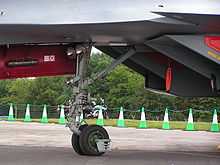Strut

A strut is a structural component designed to resist longitudinal compression. Struts provide outwards-facing support in their lengthwise direction, which can be used to keep two other components separate, performing the opposite function of a tie. They are commonly used in architecture and engineering.
Automobiles
.png)
As components of an automobile chassis, they can be passive braces to reinforce the chassis and/or body, or active components of the suspension. An automotive suspension strut combines the primary function of a shock absorber (as a damper), with the ability to support sideways loads not along its axis of compression, somewhat similar to a sliding pillar suspension, thus eliminating the need for an upper suspension arm. This means that a strut must have a more rugged design, with mounting points near its middle for attachment of such loads.
The most common form of strut in an automobile is the MacPherson strut. MacPherson struts are often purchased by the automakers in sets of four completed sub-assemblies: These can be mounted on the car bodies as part of the manufacturers' own assembly operations. The MacPherson strut combines a shock absorber and a spring in a single unit, by means of which each wheel is attached to the car body.
Transportation-related struts are used in "load bearing" applications ranging from both highway and off-road suspensions to automobile hood and hatch window supports to aircraft wing supports. In vehicle suspension systems, struts are most commonly an assembly of coil-over spring and shock absorber. Other variants to using a coil-over spring as the compressible load bearer include support via pressurized nitrogen gas acting as the spring, and rigid (hard tail) support which provides neither longitudinal compression/extension nor damping.
Architecture and construction
In piping, struts restrain movement of a component in one direction while allowing movement or contraction in another direction.[1]
Strut channel made from steel, aluminium, or fibre-reinforced plastic is used heavily in the building industry and is often used in the support of cable trays and other forms of cable management, and pipes support systems.
Strut is a common name in timber framing for a support or brace of lighter scantlings than a post. Frequently found in roof framing between on a tie beam and a principal rafter or from a king post to a principal rafter. May be plumb or leaning then called a canted strut, raking strut, or angled strut and may be straight or curved. In the U.K., strut is generally used in a sense of a lighter duty piece such as a king post carries a ridge beam but a king strut does not, a queen post carries a plate but a queen strut does not, a crown post carries a crown plate but a crown strut does not.
Strutting or blocking between floor joists adds strength to the floor system.
Aircraft
Lift struts and cabane struts were commonly used in early aircraft to support wings, stabilizers, control frames in gliders and hang gliders, and in landing gear. Since the 1930s they were mostly replaced with cantilever constructions, and became rare except in light aircraft. These structural members are frequently loaded in tension, but may vary between tension and compression as the aircraft maneuvers.
Struts are still widely used to attach the landing gear, particularly in retractable-gear aircraft, and provide damping during the takeoff and landing roll; here they are often called Oleo struts.
Human Anatomy
Part of the functionality of the clavicle is to serve as a strut between the scapula and sternum, resisting forces that would otherwise bring the upper limb close to the thorax. Keeping the upper limb away from the thorax is vital for its range of motion. Complete lack of clavicles may be seen in cleidocranial dysostosis, and the abnormal proximity of the shoulders to the median plane exemplifies the clavicles' importance as struts.
Gallery
-

ORI Strut, Off-road application of strut
-
Strut bar
-
Compression strut on Piper Pawnee (low-wing aircraft)
-

Tension strut on Shorts 360 (high-wing aircraft)
-

MacPherson Strut suspension
-

Nosewheel oleo strut on Su-30MKI aircraft
See also
| ||||||||||||||||||||||
References
- ↑ Sway Strut Assemblies Piping Technology & Products, (retrieved March 2012)

